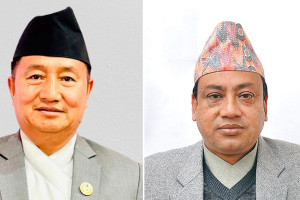Money
Completion deadline for Pokhara international airport extended
All tasks including testing of navigation and meteorological equipment may be finished by April 2022, officials say.
Sangam Prasain
The Civil Aviation Authority of Nepal has given the Chinese contractor for the international airport project in Pokhara another year to complete it in consideration of delays caused by the Covid-19 pandemic, as per the force majeure clause which permits relaxation of obligations in case of events beyond the parties' control.
The $215.96 million Chinese-funded scheme had been racing ahead of schedule, and was in line to open six months before the planned date of July 10, 2021. But the coronavirus threw a spanner in the works.
“As the project developer China CAMC Engineering asked for extra time, we decided to grant a one-year extension,” said Rajan Pokhrel, director general of the civil aviation body. The new deadline is July 10, 2022.
“This extension is based on the Covid-19 pandemic triggered lockdowns and their impact on procurement of materials and supply of workers to the construction site.”
He said that work continued during the lockdown last year and this year too, but progress slowed to a crawl as the project was shorthanded.
According to project officials, if there are no more lockdowns, all tasks—including installation and testing of the navigation and meteorological equipment, and certification of the airport—may be completed by April 2022.
But with over 2,500 new cases daily and a third wave looming, there is scepticism that the project will be completed by the extended deadline.
Pokhrel said that the project developer had asked for the one-year extension. “We decided the extension based on their request. It’s their assessment. We hope they have made a proper assessment to complete the project by the extended deadline.”
Nepali public health experts have projected that the third wave will hit the country in late August.
Prime Minister Sher Bahadur Deuba on Saturday, through a video message, warned people of the third wave of the coronavirus, and requested citizens not to venture out of their homes unless absolutely necessary.
Nepal on Sunday reported 2,548 new coronavirus cases in the last 24 hours taking the nationwide infection tally to 714,877. According to the Health Ministry, 55 people died due to Covid-19 related complications on Sunday, bringing the countrywide death toll to 10,093.
The airport is being built under the engineering procurement and construction model. Under this model, a single contractor takes responsibility for all components like design, engineering, construction and procurement. The contract binds the contractor to deliver the project at the stipulated time and predetermined price regardless of any possible cost overruns.
Pokhrel said the project had achieved 79 percent physical progress as of Sunday. “As the Covid-19 pandemic is still uncertain, we are not sure whether the remaining 20 percent of the work can be completed in a year.”
China CAMC Engineering won the construction contract for the project in May 2014.
The then prime minister KP Sharma Oli had laid the foundation stone of the project, which will serve as the gateway to the Annapurna region, celebrated as the world's most popular trekking trail, in April 2016. The construction work started in July 2017.
The government signed a $215.96 million soft loan agreement with China EXIM Bank in March 2016 to finance the construction of the airport.
The selection of the construction site, detailed engineering work and the master plan of Pokhara International Airport was initially prepared in 1971 by DIWI, a German consulting engineering firm.
This work was performed by the erstwhile Department of Civil Aviation with an Asian Development Bank loan under the Airport Development Project in Nepal.
The government had acquired 3,106 ropanis of land to build the facility in 1975.
In 1988, the Japan International Cooperation Agency (JICA) conducted a review of the new Pokhara Airport Master Plan prepared by DIWI.
JICA proposed to implement the project in two phases. The first from 1995-2000 at an estimated cost of $40 million. The second phase from 2001-10 was estimated to cost $45 million, following the completion of which the airport would be able to handle aircraft like the Boeing 757.
The runway of Pokhara International Airport is 45 metres wide and 2,500 metres long, and has an east-west orientation. It will be able to handle medium-range commercial aircraft such as the Airbus A320, Boeing 737 and Boeing 757.
The airport will have a 1,200-metre-long and 23-metre-wide taxiway connecting the runway with the parking bays, hangars and terminals.
The main international terminal building has a capacity to handle 650 passengers per hour. The airport will have three parking bays for A320-type jets with aerobridge facility, and five parking bays for ATR-type aircraft. There will be a separate terminal and parking bay for domestic flights.




 22.66°C Kathmandu
22.66°C Kathmandu
















